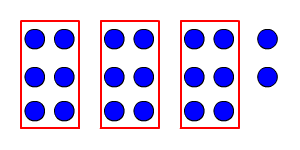Division: Whole Numbers
Division is a mathematical operation, written using the symbol , that can be thought of in two ways: is the size of each group when objects are divided into groups of equal size, OR is the number of groups when objects are divided into groups of objects each.
For example, can be found by dividing dots into groups of equal size.

We find that each of the four groups contains dots, so .
Alternately, we can find by forming groups of dots each and then counting how many groups there are:

There are groups.
Division is the inverse operation of multiplication. That is,
if and only if .
Here is called the dividend , is called the divisor , and (the result) is called the quotient .
Division by is undefined; to see why, substitute in the above equations. Since no matter what the value of , so must also equal ; and if and are both , can equal anything!
Division with whole numbers can result in a remainder. For example, if we divide by dividing into groups of , we get groups with left over:

Sometimes we write , where is the remainder .
Or, we can write a single number answer as a fraction or decimal.
Long Division
To divide a multi-digit number by a one-digit number, we can use long division.
Example 1:
Divide.
Place the dividend inside the division symbol, the divisor on the outside the division symbol.
Here, cannot be contained in , so consider the next digit also. There are eights in , so write at the tens place of the quotient.
Multiply by the divisor and subtract.
Now again cannot be contained in , so bring down the next digit .
There eights in , so write at the ones place.
Multiply by the divisor and subtract.
To divide a multi-digit number by a multi-digit number, the process is similar.
Example 2:
Divide by . Place the dividend inside the division symbol, the divisor on the outside the division symbol.
Here, cannot be contained in , consider the next digit, still cannot be contained in . So, consider the next digit also. There are thirty twos in , so write at the tens place of the quotient.
Multiply by the divisor and subtract.
Now again cannot be contained in , so bring down the next digit .
There thirty twos in , so write at the ones place.
Multiply by the divisor and subtract.
Here the remainder is .
Unlike addition and multiplication, for real numbers , the division operation is not commutative . That is, order matters: , but (a fractional value).
Similarly, division is not associative ; that is, grouping matters. For instance,
.



